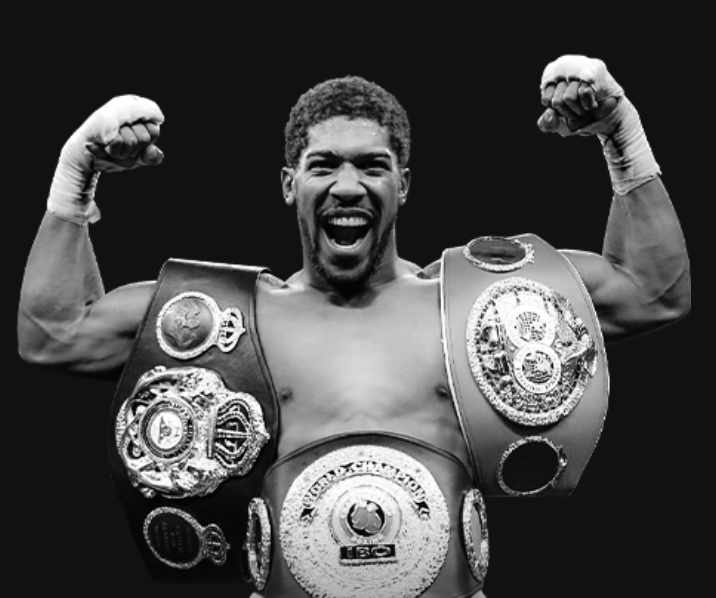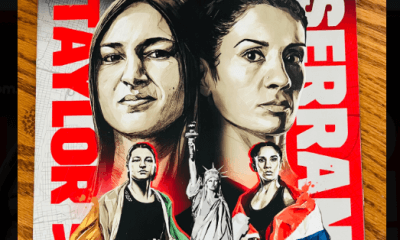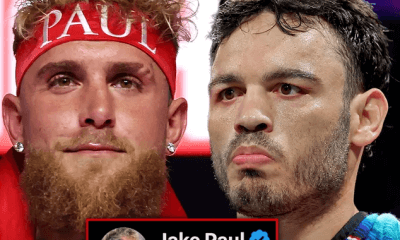Featured Articles
HITS and MISSES from a Weekend Spearheaded by a Biggie in Saudi Arabia

The fate of Anthony Joshua’s future rested on how well he performed against Andy Ruiz on Saturday in Saudi Arabia. Billed as the “Clash on the Dunes”, Ruiz vs. Joshua 2 was the most hotly anticipated rematch of 2019 and one with huge ramifications at stake far beyond the careers of the two principal participants.
Could the fairly new over-the-top streaming service DAZN survive losing three of the four major heavyweight alphabet titles to a rival organization? And might the PBC have been on its way to creating its own branded heavyweight championship if Ruiz could somehow stave off Joshua one more time?
The stakes surrounding Ruiz-Joshua 2 on DAZN really couldn’t have been higher.
Plus, there was bountiful boxing action from other places around the world, including the fourth title defense for rising junior featherweight star Emanuel Navarette on ESPN+ and the continued showcase of newly-crowned WBC middleweight titleholder Jermall Charlo on Showtime.
Here are boxing’s biggest HITS and MISSES from the first weekend in December.
HIT: Anthony Joshua Floats Like a Butterfly in Career-Defining Reclamation Project
They say you can’t teach an old dog new tricks, so it’s a good thing Anthony Joshua was still just 30 years old heading into his rematch against Andy Ruiz on Saturday in Saudi Arabia. Because Joshua boxed brilliantly over the course of 12 rounds in a way most people believed him to be incapable.
There are two common paths someone can take after suffering as humiliating experience as Joshua did when he was knocked down four times and stopped in seven rounds by Ruiz in June in one of the biggest upsets in boxing history.
Joshua could either have doubled down on his past mistakes, which included training more like a spokesperson and Instagram model than a professional fighter. Or he could rethink his entire approach and take the long way back up the mountain, which entails employing the single-minded approach of focusing all his efforts on reclaiming his heavyweight titles each and every day until the moment he steps back into the ring.
Joshua chose the latter, and it was immediately apparent as soon as he disrobed for the fight. Here appeared a man living the life of a true prizefighter now, and he went on to prove it by dominating al 12 rounds of action against the suddenly inept Ruiz.
MISS: The Predictable Failure of Andy Ruiz
If you needed a reminder about why Top Rank cut ties with the talented but discipline-challenged Ruiz at the end of last year, you saw it in Saudi Arabia. This isn’t to pile on Ruiz over the 15 extra pounds he entered the second contest carrying. In a way, that was sort of expected the moment Ruiz scored the stunning upset the first time around.
People who struggle with something like staying focused on training usually don’t suddenly become better at it unless they’re forced into it.
Humbling failures and huge successes both have a unique ability to bring out the best and worst in people. But failure often provides the opportunity for someone to accept their faults, whereas success leaves room for someone to keep denying the truth about all the things they could probably do better.
Ruiz wasn’t very competitive in the rematch. Part of it was Joshua’s newfound approach of no longer foolishly giving up his eight-inch reach advantage, but the piece that Ruiz could control in future fights would be to train seriously enough to be able to consistently apply pressure for 12 full rounds. He could hardly do it for one round on Saturday, so hopefully, the lesson has now been learned for good.
Ruiz is talented, affable and a very special fighter. It’s time for him to start treating himself that way.
HIT: Critical Heavyweight Contender Matchups on Ruiz-Joshua 2 Undercard
Boxing’s glamour division was featured mightily by promoter Eddie Hearn on the undercard of Ruiz-Joshua 2, and it’s about time a promoter did that. There’s no more important division in boxing than the action that happens above 200 pounds. Moreover, the heavyweight division is as deep and as talented as it’s been in a good 20 years or so.
So why don’t we see more heavyweights in important matchups on big fight cards? That must be what Hearn was wondering when he was putting this card together. That or it was just blind luck on his part.
Whatever the case, Filip Hrgovic appears to have all the tools to be a real contender someday, and he proved it by stopping veteran title challenger Eric Molina in the single biggest win of the 27-year-old from Croatia’s career. Hrgovic needed just three rounds to stop Molina, the same amount of time it took Joshua in 2016 and six rounds faster than Deontay Wilder did it the year prior.
Moreover, both former titleholder Alexander Povetkin and the once-beaten American Michael Hunter showed why they should figure heavily into the future of the stacked division. The 40-year-old Povetkin and 31-year-old Hunter fought to a split draw in a fun, competitive fight that showed why both deserve the chance to fight their way into world title opportunities.
MISS: ESPN’s Low-budget Treatment of Emanuel Navarette vs. Francisco Horta
It wasn’t the most compelling action of the weekend, but how could ESPN expect people to care about WBO featherweight champion Emanuel Navarette’s fourth title defense against Francisco Horta in Mexico on Saturday night if they didn’t even bother to send any of their crew over there to cover the fight?
That’s what I was wondering on Saturday when I saw ESPN’s Bernardo Osuna and Tim Bradley calling the Top Rank on ESPN+ card from the studio. That kind of thing makes sense for lesser cards from the other side of the world sometimes, but it didn’t seem to fit this case. Puebla, the city in Mexico where the card took place, is on this side of the planet and has its own international airport. What gives?
Regardless, Navarette has enjoyed a fantastic 12 months. Over his last five fights, which began when he shockingly upset Isaac Dogboe in December 2018 for the title, Navarette has solidified himself as a must-watch star. That’s a hard thing to do for someone weighing only 122 pounds, and probably even harder to accomplish in today’s world where its common to see four or five full cards airing over different networks every single weekend.
That last bit about all the other options available is why ESPN shouldn’t cheap out on its fight coverage. Either a card is important enough to show us, or it isn’t. This one deserved better coverage.
HIT: Jermall Charlo’s Emphatic Middleweight Title Defense Against Dennis Hogan
If there’s any middleweight right now who deserves a big fight against a notable opponent, it’s Jermall Charlo.
Charlo, younger by one-minute to twin brother Jermell Charlo, is a two-weight world champion who just can’t seem to get another top middleweight in the ring. So, Charlo had to be content on Saturday to dominate and stop former 154-pound world title challenger Dennis Hogan in seven rounds in the main event of the Showtime card in Brooklyn.
Charlo is the reigning WBC middleweight champion thanks to the elevation of Canelo Alvarez to whatever that organization’s “Franchise” championship is supposed to designate. Regardless, the 29-year-old remains undefeated and ready for a bigger opportunity.
One fight that makes a ton of sense is a title unification against WBO titleholder Demetrius Andrade. There’s a PR narrative pushed by Andrade’s handlers that suggests their fighter has never been able to snag a big fight against a top name because he’s so dangerous and avoided.
Of course, that isn’t the entire story. After all, Andrade was set to face Jermell Charlo in December 2014 before dropping out less than a month away from the scheduled bout after finding out how much more money Charlo was making.
Now it seems Andrade would be a good fit for the other Charlo, and everyone should hope a fight like that gets made for both fighters. That’s especially true for Charlo, who hasn’t yet been afforded a chance to prove how good he can be since stopping current unified junior middleweight champion Julian Williams back in December 2016.
Check out more boxing news on video at The Boxing Channel
To comment on this story in The Fight Forum CLICK HERE
-

 Featured Articles4 weeks ago
Featured Articles4 weeks agoAvila Perspective, Chap. 330: Matchroom in New York plus the Latest on Canelo-Crawford
-

 Featured Articles3 weeks ago
Featured Articles3 weeks agoVito Mielnicki Jr Whitewashes Kamil Gardzielik Before the Home Folks in Newark
-

 Featured Articles22 hours ago
Featured Articles22 hours agoResults and Recaps from New York Where Taylor Edged Serrano Once Again
-

 Featured Articles4 weeks ago
Featured Articles4 weeks agoCatching Up with Clay Moyle Who Talks About His Massive Collection of Boxing Books
-

 Featured Articles5 days ago
Featured Articles5 days agoFrom a Sympathetic Figure to a Pariah: The Travails of Julio Cesar Chavez Jr
-

 Featured Articles3 weeks ago
Featured Articles3 weeks agoMore Medals for Hawaii’s Patricio Family at the USA Boxing Summer Festival
-

 Featured Articles1 week ago
Featured Articles1 week agoCatterall vs Eubank Ends Prematurely; Catterall Wins a Technical Decision
-

 Featured Articles4 weeks ago
Featured Articles4 weeks agoRichardson Hitchins Batters and Stops George Kambosos at Madison Square Garden




















